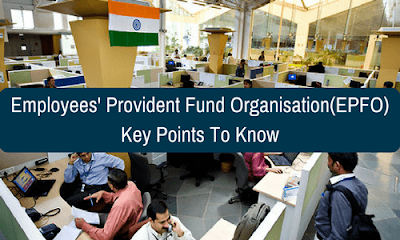Introduction
- It is an organization whose function is to assist the Central Board of Trustees(CBT) which is the apex decision-making body for EPFO.
- CBT is a Statutory body which was established under the Employees' Provident Fund and Miscellaneous Provisions Act, 1952.
- EPFO is under the administrative control of the Ministry of Labour and Employment, Union Government of India.
- EPFO assists in administering a compulsory contributory Provident Fund Scheme, a Pension Scheme and an Insurance Scheme for the workforce present in the organised sector in India.
- It covers Indian workers as well as International workers working in India.
- Any establishment that has 20 or more workers employed in 180+ industries, as specified by the government, has to register with EPFO.
- It’s one of the biggest social security organisations in the world regarding the number of members and volume of transactions undertaken.
Mission of EPFO
According to EPFO, its mission is to extend the reach and quality of publicly managed old age income security programs through consistent and ever-improving standards of compliance and benefit delivery in a manner that wins the approval and confidence of members in their methods, fairness, honesty and integrity, thereby contributing to the economic and social well-being of members.Why in News?
- In December 2016, Union Government of India notified a special campaign to enrol left out eligible workers under the EPF Scheme.
- The aim of the campaign is to encourage employers to declare details of employees who were entitled to membership between 01.04.2009 and 31.12.2016 but not able to enrol for any reason.
What is EPF(Employees' Provident Fund)?
- It is created to provide financial stability and security to elderly people, during their job or after retirement.
- An employee can start contributing to this fund when he starts his job in the organised sector.
- The purpose of an EPF is to help employees save a part of their salary every month to be used after their retirement.
- Both the employer and employee contributes to the EPF at a rate of 12% of the basic salary and dearness allowance (if any) every month. The total contribution to the EPF is thus 24% per month.
What is the rate of Interest on EPF?
- The rate of interest on EPF is decided by the Central government, after consulting the Central Trustee board(CBT) which is the apex decision-making body for EPFO.
- The notification is available on the EPF website on an annual basis.
- For Example, the interest calculated on EPFs, for the 2015-16 fiscal, was 8.75%.
- The contribution to the EPF is monthly but interest is calculated at the end of the fiscal.
What are the Tax benefits under EPF?
- The Contribution by the employer towards the EPF is exempted from Annual Income tax but the employee’s contribution is taxable but is deductible according to the provisions of section 80C of the Income Tax Act.
- The money invested by an employee initially and the money he/she finally withdraw(with interest earned) after a specific period are all exempted from the Income Tax.
What is Universal Account Number(UAN) of EPF?
- UAN is a 12-digit number allotted to an employee(by EPFO) who is investing in his/her EPF.
- It does not change with the change in jobs.
- The UAN is an umbrella for the multiple Member Ids allotted to an individual by different establishments and it also remains same through the lifetime of an employee.
- By using UAN number, the employee can avail online services provided by EPFO on UAN member portal.



